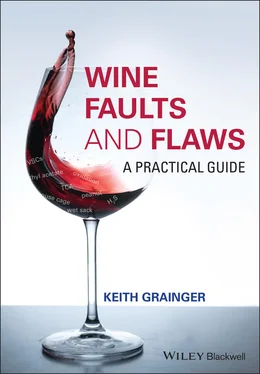Keith Grainger - Wine Faults and Flaws
Здесь есть возможность читать онлайн «Keith Grainger - Wine Faults and Flaws» — ознакомительный отрывок электронной книги совершенно бесплатно, а после прочтения отрывка купить полную версию. В некоторых случаях можно слушать аудио, скачать через торрент в формате fb2 и присутствует краткое содержание. Жанр: unrecognised, на английском языке. Описание произведения, (предисловие) а так же отзывы посетителей доступны на портале библиотеки ЛибКат.
- Название:Wine Faults and Flaws
- Автор:
- Жанр:
- Год:неизвестен
- ISBN:нет данных
- Рейтинг книги:4 / 5. Голосов: 1
-
Избранное:Добавить в избранное
- Отзывы:
-
Ваша оценка:
- 80
- 1
- 2
- 3
- 4
- 5
Wine Faults and Flaws: краткое содержание, описание и аннотация
Предлагаем к чтению аннотацию, описание, краткое содержание или предисловие (зависит от того, что написал сам автор книги «Wine Faults and Flaws»). Если вы не нашли необходимую информацию о книге — напишите в комментариях, мы постараемся отыскать её.
FLAWS
Wine Faults and Flaws: A Practical Guide
An essential guide to the faults and flaws that can affect wine
Wine Faults and Flaws — читать онлайн ознакомительный отрывок
Ниже представлен текст книги, разбитый по страницам. Система сохранения места последней прочитанной страницы, позволяет с удобством читать онлайн бесплатно книгу «Wine Faults and Flaws», без необходимости каждый раз заново искать на чём Вы остановились. Поставьте закладку, и сможете в любой момент перейти на страницу, на которой закончили чтение.
Интервал:
Закладка:
490 479
491 480
492 481
493 482
494 483
495 484
496 485
497 486
498 487
499 488
500 489
Wine Faults and Flaws: A Practical Guide
Keith Grainger
Consultant in Wines and Wine Technology
Broadway, UK

This edition first published 2021
© 2021 by John Wiley & Sons Ltd
All rights reserved. No part of this publication may be reproduced, stored in a retrieval system, or transmitted, in any form or by any means, electronic, mechanical, photocopying, recording or otherwise, except as permitted by law. Advice on how to obtain permission to reuse material from this title is available at http://www.wiley.com/go/permissions.
The right of Keith Grainger to be identified as the author of this work has been asserted in accordance with law.
Registered Offices
John Wiley & Sons, Inc., 111 River Street, Hoboken, NJ 07030, USA
John Wiley & Sons Ltd, The Atrium, Southern Gate, Chichester, West Sussex, PO19 8SQ, UK
Editorial Office
The Atrium, Southern Gate, Chichester, West Sussex, PO19 8SQ, UK
For details of our global editorial offices, customer services, and more information aboutWiley products
visit us at www.wiley.com.
Wiley also publishes its books in a variety of electronic formats and by print-on-demand. Some content that appears in standard print versions of this book may not be available in other formats.
Limit of Liability/Disclaimer of Warranty
The contents of this work are intended to further general scientific research, understanding, and discussion only and are not intended and should not be relied upon as recommending or promoting scientific method, diagnosis, or treatment by physicians for any particular patient. In view of ongoing research, equipment modifications, changes in governmental regulations, and the constant flow of information relating to the use of medicines, equipment, and devices, the reader is urged to review and evaluate the information provided in the package insert or instructions for each medicine, equipment, or device for, among other things, any changes in the instructions or indication of usage and for added warnings and precautions. While the publisher and authors have used their best efforts in preparing this work, they make no representations or warranties with respect to the accuracy or completeness of the contents of this work and specifically disclaim all warranties, including without limitation any implied warranties of merchantability or fitness for a particular purpose. No warranty may be created or extended by sales representatives, written sales materials or promotional statements for this work. The fact that an organization, website, or product is referred to in this work as a citation and/or potential source of further information does not mean that the publisher and authors endorse the information or services the organization, website, or product may provide or recommendations it may make. This work is sold with the understanding that the publisher is not engaged in rendering professional services. The advice and strategies contained herein may not be suitable for your situation. You should consult with a specialist where appropriate. Further, readers should be aware that websites listed in this work may have changed or disappeared between when this work was written and when it is read. Neither the publisher nor authors shall be liable for any loss of profit or any other commercial damages, including but not limited to special, incidental, consequential, or other damages.
Library of Congress Cataloging-in-Publication Data
Names: Grainger, Keith, author.
Title: Wine faults and flaws : a practical guide / Keith Grainger.
Description: Hoboken, NJ, USA :Wiley-Blackwell, 2021. | Includes bibliographical references and index.
Identifiers: LCCN 2021001638 (print) | LCCN 2021001639 (ebook) | ISBN 9781118979068 (cloth) | ISBN 9781118979099 (adobe pdf) | ISBN 9781118979075 (epub)
Subjects: LCSH:Wine and wine making-Gaging and testing.
Classification: LCC TP511 .G73 2021 (print) | LCC TP511 (ebook) | DDC 641.2/2-dc23
LC record available at https://lccn.loc.gov/2021001638
LC ebook record available at https://lccn.loc.gov/2021001639
Cover Design: Wiley
Cover Image: © RomanKozhin/Shutterstock
To Paula .
Acknowledgements
So many people have imparted knowledge, opinions and assistance that have helped me write this work, that this list of acknowledgements is more notable for the numerous omissions than the names included. However, I would like to give particular thanks to Carlos de Jesus, Paulo Lopes and Joana Mesquita of Amorim, Matt Thomson of Kiwi‐Oeno Consultancy and Blank Canvas Wines, Sebastian Beaumont, Gordon Newton Johnson, Chris Alheit, the late, great Paul Pontalier of Château Margaux, Alfred Tesseron of Château Pontet‐Canet of Château Belgrave and other Dourthe properties, Jean‐Luc Columbo, Nicolas Joly, Sandro Bottega, Ernie Loosen, Raimund Prüm, José and Sebastien Zuccardi, Philip Tuck MW, Gordon Burns, and Evin Morrison of ETS Laboratories, Matthias Hüttl of LANXESS, Gordon Specht and Ann Dumond of Lallemand, Pascal Chatonnet, Gevork Arakelian, and Ken Walker. Finally, thanks to Nick Catley, Trevor Elliott and Hazel Tattersall for reviewing individual chapters.
Preface
Wines are produced today in over 65 countries, and it is often stated that production standards are higher than at any time in the 8000 or more years of vinous history. The consumer rightly expects any wine purchased to be of good quality, bearing in mind the price point, and free from fault, flaw, or taint. Wine critics, writers, producers, and retailers are all in the business of selling enjoyment and entertainment, for nobody has to drink wine – it is a beverage to be savoured. However, the incidences of faulty wines reaching the consumer are greater than would be regarded as acceptable in most other industries. It is claimed that such occurrences are less than was the case in recent recorded history, and it is true that the frequency of some faults, flaws, and taints being encountered in bottle (or other packaging) has declined in the last few decades. Gone are the days when a bottle of dry white Bordeaux would have more ‘struck‐match’ sulfur odours than the aromas of Sémillon or Sauvignon Blanc, and a white Bairrada exude the ‘Oloroso Sherry‐like’ aromas and bitter palate resulting from oxidation. Happily too, in recent years, there has been a considerable reduction in the occurrence of haloanisole contamination (often referred to as ‘cork taint’), which renders heavily affected wines undrinkable, having the musty odour of damp hessian or dry rot. However, incidences of certain faults and taints have increased, and issues that were once unheard of now affect many wines offered for sale. These include ‘reduced’ aromas, premature oxidation (premox), atypical ageing and, very much on the rise, smoke taint.
The reduction in the occurrence of some faults might have been expected with the increased sophistication and regulation of wine production, and the advance in scientific and technical knowledge of grape growers and winemakers. These, taken together with the utilisation of a vast array of high specification production equipment, might lead the consumer to believe that they are extremely unlikely to be faced with a faulty bottle of wine. This is sadly not the case. The increased incidence of some defects is, prima facie, surprising. However, the styles of wines that consumers want, or are perceived by the industry to want, have changed in the last 20 years or so. Grape harvests are often delayed until so‐called phenolic ripeness and, together with the effects of climate change, this has resulted in higher grape sugars, higher pH, and lower acidity. Each of these presents dangers. In the case of red wines, and particularly those at so‐called ‘entry‐level’, tannins are softer, and levels of residual sugar have often increased. Inexpensive wines are usually brought to the market very quickly, sometimes within a few months of harvest. Time is money, and there may be little time or budget for all desirable stabilisation procedures to take place. Finally, the consumer and especially the serious wine lover, wants wine to be a natural, agricultural product that has been turned into something wonderful by an artisan, not a scientist. Accordingly, many producers strive to make wine as ‘natural’ as possible, by reducing interventionist techniques and minimising chemical and biological additions, including those that may increase stability and prevent the onset of certain faults. It is also of concern that there is an increase in the incidence of mycotoxins in wines, due to their production by some of the microbial populations on vines. This is perhaps another consequence of climate change. Related off‐flavours, which were historically noted only occasionally, have been detected at a much higher frequency during the last 15 years.
Читать дальшеИнтервал:
Закладка:
Похожие книги на «Wine Faults and Flaws»
Представляем Вашему вниманию похожие книги на «Wine Faults and Flaws» списком для выбора. Мы отобрали схожую по названию и смыслу литературу в надежде предоставить читателям больше вариантов отыскать новые, интересные, ещё непрочитанные произведения.
Обсуждение, отзывы о книге «Wine Faults and Flaws» и просто собственные мнения читателей. Оставьте ваши комментарии, напишите, что Вы думаете о произведении, его смысле или главных героях. Укажите что конкретно понравилось, а что нет, и почему Вы так считаете.












